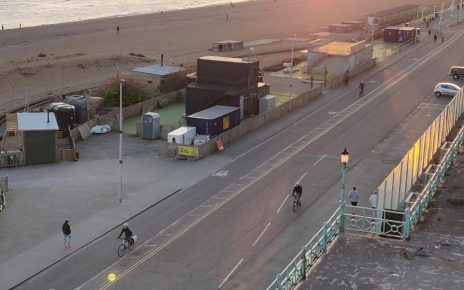Nearly three years after Chicago was named the top city for bicycling in a survey by a national magazine, biking advocates say the city is falling behind other cities and is not doing enough to pursue its stated goals of making biking safer for all types of riders.
Advocates cite a dwindling commitment to expanding protected bike lanes and installing side guards on the city’s fleets of trucks, as well as drivers and businesses that use bike lanes like parking spots.
The latest push to increase efforts toward improving bike safety comes following the death of three cyclists in less than a month.
The most recent was a 40-year-old man struck early Sunday on the South Side, just a day before officials plan to hold a memorial for victims of traffic deaths on Monday in the atrium of the Thompson Center, 100 W. Randolph St., by lining up pairs of shoes representing the number of people killed this year in the city.
Though an ambitious 2012 plan called for the city to identify a 645-mile network of on-street bikeways for development and to “build more protected bike lanes than any other city in the country” by 2020, city data shows that only 8% of the city’s 327 miles of bike lanes are protected by concrete curbs and/or plastic bollards.
That trails New York City, which has 1,250 miles of bike lanes — including 126 miles of protected — or 10%, according to The New York Times. New York also plans to build 250 more miles of protected bikes lanes after a slew of biking deaths this year.
San Fransisco has nearly as many miles of protected lanes as Chicago, despite being 20% of its size, according to advocacy group People for Bikes. The Twin Cities have 51 combined miles of protected lanes — nearly double Chicago despite being a fraction of the size.
Bike lane construction slows
In Chicago, the pace of bike lane construction has slowed dramatically in recent years. Between 2012 and 2015, the city built or upgraded 116.25 miles of bike lanes, including nearly 20 miles that were protected, data shows. But in the four years since, the city added about half of that amount, or just 66.4 miles. And only 8.5 miles of those were protected.

“Protected bike lanes make a real difference in safety. That’s where you get the greatest reduction in crashes and also get more people riding because they feel more comfortable,” according to Michael Whitehead, a spokesman for the advocacy nonprofit Active Transportation Alliance. “We’ve definitely made progress, but this [latest] tragic crash demonstrates we still have a long way to go.”
Fewer fatalities
Between 2012 and 2018, the city saw an average of 5.5 bicyclists killed per year. The highest was 2012 when eight fatalities were reported, city records show.
Even with the recent deaths, Chicago is on track to see the least number of fatalities since 2013. But advocates say the improvements they keep calling for would encourage more people to ride bikes and could have helped prevent the most recent cycling deaths.
The crash early Sunday happened on a stretch of Stony Island where the city has proposed installing protected bike lanes but those have reportedly been opposed by local aldermen in the past.
Carla Aiello, a 37-year-old mother and teacher at a city Catholic school, was killed Nov. 6 when a truck driver struck her while making a right turn from Milwaukee Avenue onto Kilbourne Avenue, authorities said.
Safe cycling advocates call the type of crash that killed Aiello a “right hook,” where a vehicle traveling in the same direction as the cyclist turns in front of the biker, who gets trapped under the truck’s wheels.
To reduce these deaths, in 2017, advocates lobbied officials to pass a city ordinance that required the city’s truck fleet be equipped with side guards — which prevent someone from falling under a truck’s wheels — and convex mirrors by 2026 and on trucks operated by companies with city contracts by 2021.
City spokesman Michael Claffey said the guards will be installed on 50 of the city trucks by the the end of the year — only about 5% of the total fleet that will eventually receive them. The city will need to install the guards on about 135 trucks per year going forward to meet its deadline.

Advocates would like to see the rollout for the ordinance happen faster and see it broadened to include more of the thousands of trucks that drive through the city every day.
“We have been working on this for years because we continue to hear about these crashes,” Whitehead said. “There are a lot of trucks traveling in the city that aren’t city contractors or part of the city’s fleet.”
Whitehead said his group plans to lobby in Springfield next year for the guards to be required on all large trucks registered in the state.
Parking in bike lanes
A close call with a “right hook” incident in 2016 led Christina Whitehouse to start Bike Lane Uprising, a website that allows registered users to track bike lane obstructions.
News of Aiello’s death hit close to home for Whitehouse, who said bicyclists “all identify with these crashes, because they’re having close calls every day.”
Whitehouse relies on the city’s Divvy program for transportation. When drivers park in bike lanes it forces cyclists to merge into faster moving traffic, increasing the risk of injury and road rage incidents, she said.

She would like to see the city crack down, particularly for repeat offenders like businesses that use the lanes to park trucks and for ride-sharing companies that use them for drop-offs.
In 2018, Bike Lane Uprising users alone reported 5,461 instances of obstructed bike lanes, “only a fraction of what occurs,” Whitehouse said. Although the city has 13,500 workers able to write tickets for obstructing bike lanes, 3,946 tickets were issued last year, the site’s data showed.
Advocates cautioned against the city simply writing more tickets, believing both that it won’t change behavior and could disproportionally impact disenfranchised communities.
Whitehouse said she would like to see the city focus on repeat offenders, particularly ride sharing, taxi and company trucks that make up 45% of violators reported to the site in 2018.
“It shows there’s not a lot of respect for the lines,” Whitehouse said. “Some businesses use them as their own personal distribution centers.”



